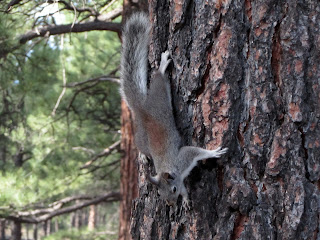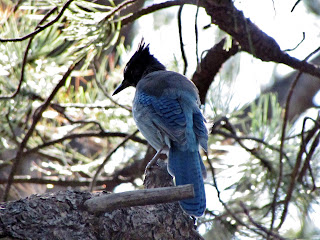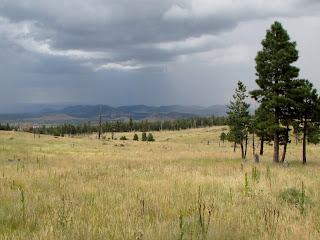A few weeks back I had the opportunity to backpack in
Sequoia/Kings Canyon National Park with my sister and some friends. Sequoia and
Kings Canyon are a pair of National Parks located in the western Sierra Nevadas
of California, a few hours’ drive south of Yosemite. Sequoia National Park
receives only a quarter of Yosemite’s 4 million annual visitors and Kings
Canyon only half of that. However, the parks have a combined 865,000 acres of
land compared to Yosemite’s 748,000 making them much less crowded, especially
in Kings Canyon. This made a visit to the parks the ideal choice for my sister
when her permit application to hike Half Dome was unfortunately denied due to
the popularity of the hike. Instead she set her sights on the Twin Lakes Trail,
a trek up to alpine lakes along the border between Sequoia and Kings Canyon.
This alternate trip also moved the adventure further south, making it a bit
more accessible for me to drive in from Phoenix. I not so subtly hinted that it
would be something I’d like to do and was quickly invited to fill a spot on the
backcountry permit.
Formed in 1890 to preserve the groves of Giant Sequoias from
loggers, Sequoia National Park is the second oldest in the parks system behind
Yellowstone. Kings Canyon came along 50 years later in 1940, absorbing the
General Grant National Park (created alongside Sequoia to preserve another
grove of Sequoias). This year was a year of celebration as the 125th
anniversary of Sequoia and 75th anniversary of Kings Canyon. The
parks essentially function together, creating an awesome experience traversing
several ecosystems ranging from the hot dry foothills region of the park to the
groves of massive Giant Sequoias and alpine lakes. The parks are a land of
superlatives, boasting the highest peak in the contiguous United States (Mount
Whitney – 14,505 ft.) and the largest tree in the world by volume (General
Sherman – 52,500 cubic ft.). The parks contain 97 miles of the John Muir Trail
(75 in Kings Canyon and 22 in Sequoia) and over 800 miles of trails. Speaking
of which, if you haven’t seen Mile, Mile and a Half yet do yourself a favor and
watch it.
After a few months of anxiously awaiting our hike and
watching Mile, Mile and a Half on repeat to get myself psyched for the Sierras,
the weekend finally came. I loaded up the car and began the 600 mile drive to
Sequoia. I split the drive up over two days, stopping for the night at Mojave
National Preserve (an extremely underrated park that I’ll be posting about
later). After barely sleeping with excitement I packed up camp at 4 AM and
cruised through the Mojave Desert and into the San Joaquin Valley. I passed
through Bakersfield and the miles after miles of orange groves and fruit farms
until I saw the peaks of the Sierras cresting in the distance. Coming from the
south, the entrance to the park takes you through the golden hills of Three
Rivers, CA and past Lake Kaweah, a reservoir built by the Army Corps of
Engineers as a means of controlling flooding from the snowmelt of the mountains
behind it. Highway 198 continues along the Kaweah River and enters Sequoia
National Park in the Foothills, a section of the park characterized by low
elevation, hot, dry air and chaparral. The Generals Highway carries you up a
winding road nearly 5,000 feet to the Giant Forest where you gain your first
glimpse of the incredible Giant Sequoia Trees.
 |
| Lake Kaweah from Highway 198 |
 |
| Driving through The Giant Forest on Generals Highway |
We would be camping the first night at Lodgepole Campground, located just past the Giant Forest on Generals Highway. Arriving early on Friday afternoon, I had time to squeeze in a day hike while I waited for everyone else to arrive. The rest of my fellow backpackers would be coming from San Francisco a few hours after me. Lodgepole is home to the trailhead of the Twin Lakes trail, which we would be hiking in the morning, and the Tokopah Falls Trail, a short 3.4 mile out and back trail along the Marble Fork of the Kaweah River. The trail ends at Tokopah Falls, which cascades 1,200 feet down into Tokopah Canyon. With only 530 feet of elevation gain along the trail, it was a super quick hike out to the falls. However, I brought a fly rod and spent the afternoon attempting to catch Brook Trout as I hiked back. The trout were present in pretty good numbers and I found a nice pocket of water where I had managed to hook 3 of them on elk hair caddis but lost them before I could put them in the net. After about 20 minutes of laser focus on the water and no bites, I turned around to see a mama Black Bear and her cub crossing the river about 150 ft. behind me. I was extremely nervous at first because I had never encountered bears in the wild besides seeing them from the safety of a car and this was waaay too close for comfort. Standing barefoot in the river with only a fly rod, net, and a camera, I did the first logical thing I could think of which was to start snapping pictures before climbing out of the water and backing away slowly. However, besides being a bit curious as I backed away from her, she seemed not to notice my presence. I watched her and the cub from across the river and used my zoom lens to its full potential. I watched her tear the bark off of a tree, most likely searching for food. I also watched as her cub proved that yes, bears do in fact shit in the woods. As other hikers began to notice the bears and began approaching to take pictures (from a respectful distance) I gathered my daypack and shoes and headed back into the campsite. I didn’t catch a single fish but I had one of the coolest experiences I’ve ever had on the water.
 |
| Kaweah River along Tokopah Falls Trail |
 |
| Tokopah Canyon |
 |
| Tokopah Falls |
 |
| Black Bear and cub, Tokopah Falls Trail |
 |
| Black Bear |
 |
| Kaweah River along Tokopah Falls Trail |
 |
| Coneflower |
 |
| Mountain Quail |
The campsite itself is located along the Kaweah River and is very calming until you see the constant reminders that there are big furry creatures that want to eat all your food everywhere around you. There were bear bins at each site and signs everywhere warning to put everything and anything a bear might find tasty into the bins overnight and anytime you stepped away from the campsite. A ranger told us that there had been 3 car break-ins that week! The sites were slightly crowded together but everyone around us was really cool. The rest of the group arrived and after a dinner of slightly burned Dutch oven deep dish pizzas we fell asleep wondering if we might be visited by my friends from the river, waking the next morning to the sounds of Stellar’s Jays and the smell of pine.
We got started at the Twin Lakes Trailhead around 10 AM. The Twin Lakes trail takes hikers 7 miles and 2600 ft. up to Twin Lakes, two alpine lakes that sit at 9400 feet. Being 14 miles roundtrip it can either be done as a long day hike or an overnight backpacking trip, and our company along the trail seemed to be a pretty even split between the two ways to hike the trail. We would be continuing past Twin Lakes an extra 3 miles to Ranger Lake, which many hikers use as a way to connect to even more remote trails in the Sierra backcountry. The trail started off with a decent climb up through the pine forest surrounding Tokopah Canyon and we were treated to beautiful views of the valley as we ascended. After about 2.5 miles of hiking and approximately a 1000 ft. elevation gain we arrived at Cahoon Meadow, a beautiful open meadow and perfect point to take a break.
 |
| Twin Lakes Trailhead |
 |
| Twin Lakes Trail outside of Lodgepole |
 |
| Cahoon Meadow |
The next mile and a half featured another 1000 foot climb through the forest up to Cahoon Gap, which featured a nice view back down onto the meadow below. We continued past the trail to J.O. pass and were treated to patches of Lupines, Leopard Lily, and Indian Paintbrush along the wooded trail. We stopped for another break along the East Fork of Clover Creek, a stream that flows from Twin Lakes steeply down the mountainside. The cold water felt amazing after nearly 6 miles of hiking.
 |
| Cahoon Meadow seen from Twin Lakes Trail |
 |
| Cooling off in Clover Creek |
We arrived at Twin Lakes around 2 PM and spent a relaxing two hours enjoying the cool water. The water temperature was somewhere in the low 70s or high 60s so it was definitely a bit cold at first but it was so enjoyable to be cooling off in the alpine lake. I spent most of our break fly fishing and had no luck despite seeing at least a dozen trout rising to feed on insects at the surface of the lake. Talking to other fishermen I found out that the few that had success were using small spinner baits while all the fly fishermen were coming up empty handed. After a bit more swimming and enjoying a lunch of oranges, tuna, and of course cold Sierra Nevada Pale Ales we began our ascent up the looming Silliman Pass to cross into Kings Canyon.
 |
| Twin Lakes |
 |
| When in Rome... |
 |
| Twin Lakes viewed from trail up Silliman Pass |
Silliman pass sits at 10,479 feet, approximately an additional mile hike and 1000 ft. above Twin Lakes below. At Silliman pass you officially cross into Kings Canyon National Park and are treated to a dramatic panoramic view of the Sierras rising to the east and Mt. Silliman, which stands 11,188 ft. After a pretty difficult climb and the effects of the thin air slowing us down, we stopped to enjoy some photos of the beautiful Kings Canyon scenery. We began our 2 mile, 1000 ft. descent down to Ranger Lake and enjoyed scenic overlooks of Beville Lake on the way down.
 |
| View from Silliman Pass towards Mt. Silliman |
 |
| Beville Lake viewed descending from Silliman Pass |
 |
| Descending towards Ranger Lake |
We arrived at Ranger Lake just as it began to get dark and spent a good half hour hunting for the bear boxes to stash our gear (which we eventually found no thanks to me). Ranger Lake was much more remote than Twin Lakes sitting only 3 miles away on the other side of Silliman Pass. Our group was the only one spending that night at Ranger Lake, besides the family of mosquitos that I was definitely not used to after spending the past year and a half in the desert. Ranger Lake also allows campfires, whereas Twin Lakes does not. However, after a full day of hiking we were so tired that we immediately went to bed following some rehydrated Mountain House Meals. My favorite was the Cuban Coconut Blackbean and Rice. After a few hours sleep we got up to catch the sunrise at Ranger Lake and another beautiful view of the Sierras illuminated by the eastern light. It’s pretty amazing how much different lighting can change a view so much. We returned back to Lodgepole uneventfully back the way we came, this time being able to encourage oncoming hikers of how close they were to their destination.
 |
| Ranger Lake |
 |
| Trail back up Silliman Pass |
 |
| Trail back up Silliman Pass |
 |
| Beville Lake |
 |
| My sister is awesome |
 |
| Our friends and fellow backpackers |
 |
| Leopard Lily |
Upon returning back to Lodgepole and finding that none of our extra food or beer was stolen out of the unlocked bear box (I truly believe that you see the best of humanity when you visit the National Parks) we packed up and made our last stop in the park before heading home, The Giant Forest and General Sherman Tree. The Big Trees Trail through the Giant Forest is the complete opposite of the quiet backcountry trails that we had traversed over the past two days. Crowds of people and families with small children roam along the half mile trail to the General Sherman Tree, admiring the incredible size of the Giant Sequoias around them. The centerpiece of the whole forest is the General Sherman Tree, the largest tree in the world by volume. In 1879 the tree was named after General William Tecumseh Sherman, the famous Civil War General, by a naturalist named James Wolverton who had served under Sherman in the military. General Sherman stands 275 feet tall and measures 36.5 ft. in diameter at its base. I had seen General Sherman once before in 2012 on a brief day trip to the park with some friends from Los Angeles, so seeing the tree again brought back some great memories and cemented some awesome new ones.
 |
| General Sherman Tree |
 |
| Giant Sequoias in The Giant Forest |
After a walking back to the car we split our separate ways
and began our respective drives back to San Francisco and Phoenix. I stopped
again for the night in Mojave National Preserve and made my way back home in
time to get to school late on Monday afternoon. What an incredible trip!
Trails we hiked:
Tokopah Falls Trail to Tokopah Falls, 3.4 miles round trip,
530 ft. elevation gain/loss
Twin Lakes Trail to Ranger Lake, 20.2 miles round trip, 3700
ft. elevation gain up to Silliman Pass
Big Trees Trail to General Sherman Tree, 1 mile round trip,
200 ft. elevation gain/loss











































































